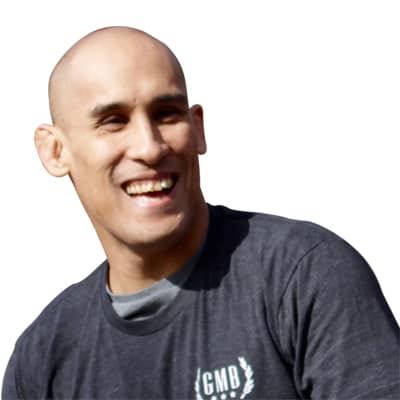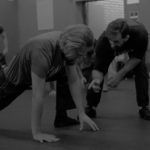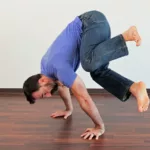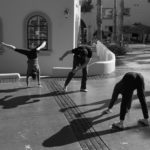You’ve been following a nice new training program for a couple of months and you’re getting better at your workouts. But, it’s just not translating into progress in the things you care about.
Sure, you can lift more weight than when you started, but you don’t notice too much carry-over into your sport/activity/hobby/twerking.
Fundamentally it’s because if you don’t have a lot of understanding about what is specifically holding you back, a lot of decisions you make about what sort of training to focus on are just guesswork.
And when you’re just guessing about decisions in your training, you’re not in control of your progress.
And that’s holding you back from making the kind of progress you want to make – and should be making – with your training. No matter what skill you want to learn, or if you just want to move and feel better, you’ll want to know what’s really limiting you. Most people struggle with this because how do you know what you need to work on if it’s never been pointed out to you?
It’s time to take back that control so you can achieve your goals, once and for all.
1-Minute Elements Readiness Assessment
We’re gonna start at the low-end baseline with a readiness assessment. This video represents the minimum ability required to use our Elements program:
This is a quick assessment you can do right now wherever you are. The hardest part is the self-reflection about how you did, what went well, and what needs work.
Basic Assessment: Get Down and Get Back Up Again
Put hands on floor, sit down on the ground and sit back. Now shift forward to hands and knees, stand up again. It doesn’t matter if knees are bent/straight, or if you use your hands or not. Just can you do it.
- Do you feel tight/stiff getting up?
- Do you feel like a lack of flexibility is hindering you or is it that your knees and hips could be a bit stronger in the position?
And that’s it! A simple thing but after you spend a bit of time analyzing how you did, you can already see what it reveals about how you can move.
Bonus Assessment: Going Deeper
If that felt pretty good, try this bonus assessment.
On hands and knees, can you shift your weight forward onto your hands and hold for 30 seconds. If that feels okay, now do the same shift but now lift one knee up off the ground, and repeat on the other side?
- Do you feel wobbly doing this?
- How’s the shift towards your hands? Do you feel equally strong through both hands? How are your shoulders/elbows/wrists?
- Is it more difficult on one side versus the other when you lift a knee up?
So say you can do these movements fairly easily, but maybe you notice one or two things that could be much better? What are they? Do you notice that you could have more control in shifting weight from your legs to your hands? Maybe you feel your back and hips are tighter than you’d like when you get up from the floor. Or your right shoulder was a bit wonky when you shifted and turned to stand.
Ongoing Self-Assessment During Regular Training
This type of self-assessment and self-reflection is much more valuable than any arbitrary standard that someone wants you to meet.
And this is what at the heart of locomotion training. What looks like just crawling around actually gives you the opportunity to assess your limitations and work on them right away. These simple movements you just assessed are the foundation for more complicated movements that are part of a comprehensive plan to get you moving better.
If you can’t do the movement you want, there’s some kind of limitation. Push-ups are a nice simple example. If you can’t do a push-up, it’s usually a lack of one or more of the following:
- Upper body strength (shoulders, chest, arms)
- Flexibility (wrists, shoulders, back)
Again very simple and basic, but it gives you an idea of the fundamentals of what to look at.
But what about the more complex problem of why you feel like you’re stuck in your progress overall?
Specific Assessment: What’s Really Holding You Back?
We categorize movement fitness capabilities into three categories: Strength, Flexibility, and Control.
If you’re training right now you likely already know how to assess your strength. Whether it’s lifting weights or your body or hitting/kicking a ball. It’s relatively easy to see where you are strong and where you need some work.
Especially in the activities you like to do all the time. Is it easier/harder to hike up your regular trail? Feeling good about how far you’re driving that golf ball?
What you may be missing is your strength in particular positions that you aren’t in all the time. Can you easily get up from a full squat or kneeling? How’s your shoulder strength when your arms are behind you? These types of things can tell you a lot about what would be helpful for you to spend a bit more time on.
The same with flexibility. We tend not to spend time in positions that are difficult or uncomfortable. Of course, why would we want to?! Unfortunately, “use it or lose it” is a true statement. And as the years go by, whatever we neglect becomes more difficult until one day we find we can’t do it at all.
Motor control, or coordination or “balance”, is simply our ability to perform a movement with ease and grace. Since motor control is largely about coordination and balance, most people think of highly athletic movements, like flips and twists.
But really, it’s much more about the regular coordination and balance you need in your daily life. Reaching and twisting while up on your toes isn’t just an acrobatic trick when you have to get that box out from storage. Let alone scrambling for a hand hold on your favorite hiking trail.
Use These Assessment Tips to Take Control of Your Progress
Refer to a Measurable Scale
Assessment without measurement doesn’t really tell you much. The specific scale you use doesn’t really matter, as long as you use the same scale each time you retest, so you can measure your progress. But we have found that re-framing how you think about exercise and your movement enhances your progress. Instead of equating high effort with what you want in a workout, go for improving the ease and quality of how you move.
In our programs, we use the following scale for ease and quality:
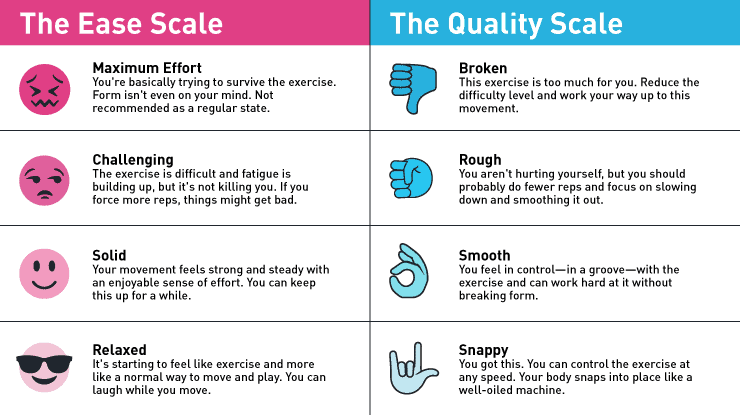
If you prefer a standard 10-point scale, that works too. Here’s how that would line up with our worded scale. A 10 is what you want to strive for.
Rating Ease
- Maximum Effort: 1-2
- Challenging: 3-5
- Solid: 6-8
- Relaxed: 8-10
Rating Quality
- Broken: 1-2
- Rough: 3-5
- Smooth: 6-7
- Snappy: 8-10
Be Realistic, But Not Pessimistic
There’s a tendency for people to overinflate their scores because it feels good to look at a score sheet and see you’ve done well. But remember, you’re using these assessments to help you see what needs work so that you can improve. Be realistic about your performance.
On the other hand, don’t get down on yourself if you didn’t do as well as you’d hoped. If you get too down about your performance, you might give yourself a lower score than you actually deserve.
Use this as an opportunity to be introspective and really figure out what’s going on with your body.
Remember: “Ideal” Doesn’t Mean Perfect
When you’re rating your performance you are striving for improvement and perhaps that ideal form. But what does that really mean?
It doesn’t mean you have to look exactly like someone doing the exercise perfectly. “Ideal” is going to be somewhat different for every person. But your ideal form should include some key things like good posture and control.
Remember that the assessment you’re using is of yourself – your abilities and your weaknesses. So don’t compare yourself to others. Use this assessment to have a baseline against which you can compare yourself to yourself.
Reassess Yourself Regularly
This is key. Whatever assessments you used the first time around, go through it again the same way. With regular assessments, you can see how you’re progressing and what likely needs work.
Be aware, however, that your progress will not necessarily be linear. Don’t treat assessments like “tests” you need to pass. You may have a day where things just aren’t going well. That’s okay. Look at your progress over time, rather than from one assessment to the next.
If the general trend is in the right direction, what you’re doing is working. If the trend is downward, it’s time for some further reflection on why that may be happening. Do you need to make major changes or slight tweaks? You’ll only know the answer to that when you “check in with yourself” regularly.
Stop Guessing – Start Calling the Shots
It’s frustrating to work hard at something and not get the results you want. It can make you feel like you have no control over your situation.
While it’s true that we can’t completely control the outcomes of the efforts we put in, we can – and should – control which efforts we put in, and adjust them when things aren’t going the way we want them to.
Regular and directed self-assessment is the key to taking control of your training and your progress. The quick assessments you just went through while reading this article should have already told you quite a bit about your current condition and, depending on what you discovered, you may have a good idea of where to go with that information.
If not, though, our Elements course has self-reflection and continual assessment built in to each session. Because you have to practice that just like you practice a move to get better at it.
The more you practice rating your ease and quality to match the key points and cues of the movements, the quicker and more confident you’ll be in reflecting on how you’re doing.
Spend as much time as you can in each session to self assess and you’ll gain a targeted focus on your specific needs, so you can stop guessing about what exercises you need, and start addressing those needs head-on.
Assess and Address Your Physical Needs
With Elements, you’ll follow a clear program, based around regular and directed assessments, so you can address your needs and take control of your progress.


